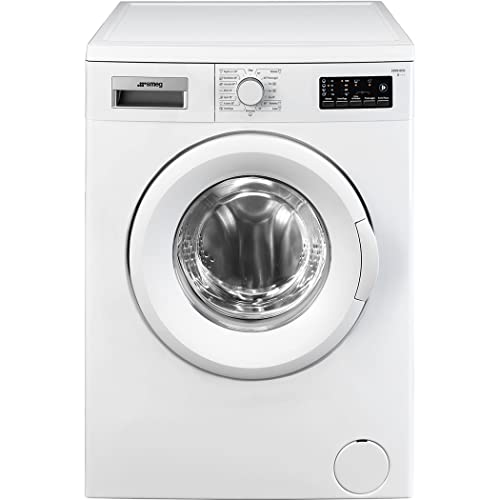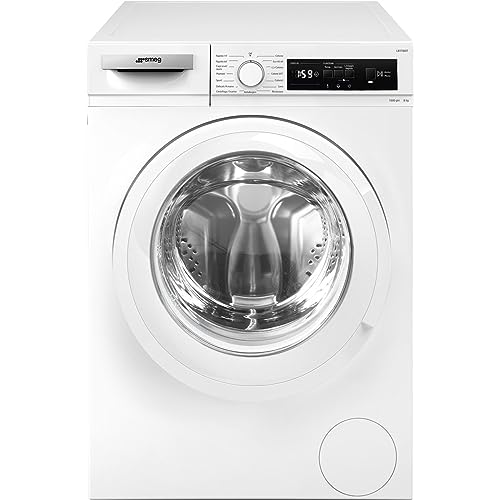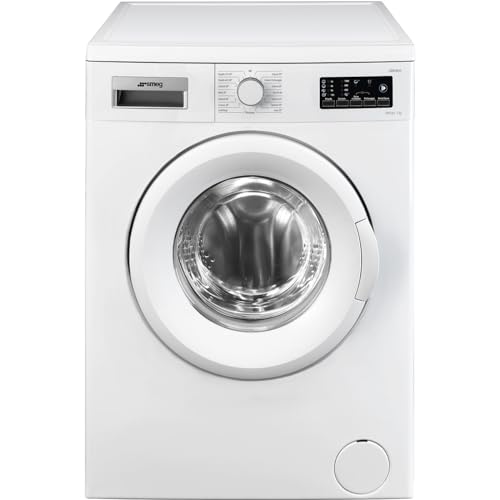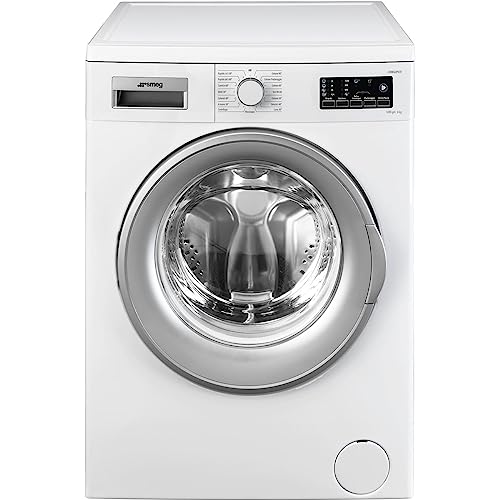Are Smeg washing machines good?
Smeg washing machines, on average, do not perform as well as many other brands. They achieve an overall score of 5.2 points, placing them in the lower rankings among brands. User ratings for Smeg washing machines are also modest, with an average score of 6.9 points, positioning them near the bottom in customer satisfaction rankings.
If you are looking for better washing machines, check out models from AEG, Electrolux, LG, or Hisense.
(These rankings are based on a comparison of 26 brands, excluding those with fewer than 3 products in the database.)
The following chart shows the overall scores of the best washing machine brands.
[horizontal-chart-70247564]
The best Smeg washing machines (with the highest overall scores) are listed below.
- Smeg WHT814ASIT (Overall score: 7.51 points; Capacity: 8 kg)
- Smeg LBW60IT (Overall score: 5.47 points; Capacity: 6 kg)
- Smeg LB1T80IT (Overall score: 5.22 points; Capacity: 8 kg)What are the main advantages of Smeg washing machines?
Smeg washing machines have the following advantages compared to other brands.
- Lower price: Smeg washing machines are on average £140 cheaper than the market average (£240 vs. £380), with a quality-price ratio of 7 points.
- Efficient water consumption: Smeg washing machines consume on average 3 litres less water than the market average (43 L vs. 46 L).
- Diverse washing programs: Smeg washing machines offer a similar number of washing programs to most other brands (15 programs).
- Advanced washing functions: Many Smeg washing machines include features such as pre-wash, extra rinse function, rinse hold, fast function, steam technology, and anti-crease function.
- Comprehensive features: Nearly all Smeg washing machines are equipped with a foam control system, load balancing system, and laundry detection system. Some models may include additional features such as overflow protection, self-cleaning, and steam technology.
What are the main disadvantages of Smeg washing machines?
Smeg washing machines have the following disadvantages compared to other brands.
- Lower user ratings: Smeg washing machines have an average user rating of 6.9 points, compared to the market average of 8.1 points.
- Lower popularity: The average popularity of Smeg washing machines is 3.3 points, while the market average is 6 points.
- Lower capacity: Smeg washing machines have an average capacity of 6 kg and a drum volume of 44 L, both below the market average (8 kg and 58 L).
- Higher energy consumption: Smeg washing machines consume 65 kWh per 100 cycles, compared to the market average of 55 kWh.
- Lower maximum spin speed: Most Smeg washing machines have a maximum spin speed of only 1000 rpm, lower than the market average of 1400 rpm.
- Spin speed limitations: None of the Smeg washing machines can reach the minimum spin speed of 400 rpm, whereas 67% of other washing machines can.
- Noisier operation: Smeg washing machines have slightly higher noise levels, with 76 dB during spinning and 58 dB during washing, compared to the market averages of 75 dB and 53 dB.
- Missing washing functions: Smeg washing machines lack features such as the silent function, Water+ function, or soak function.
- Lack of advanced features: Smeg washing machines do not include advanced features such as pre-mix technology, automatic dosing systems, automatic drawer cleaning, smart diagnosis, memory functions, Wi-Fi connectivity, or AI technology.
- Few models with inverter motors: Only a very limited number of Smeg washing machines are equipped with an inverter motor.
Who manufactures Smeg washing machines?
Smeg washing machines are manufactured by the Italian company Smeg S.p.A., founded in 1948 by Vittorio Bertazzoni Sr. and headquartered in Guastalla, Emilia-Romagna. Initially focused on enamels and metals, the company introduced its first washing machine, the “Leda,” in 1963.
Still managed by the Bertazzoni family, Smeg is known for combining technology with elegant design, maintaining an emphasis on the “Made in Italy” tradition that blends craftsmanship and innovation. While famous for retro-style kitchen appliances, Smeg also produces washing machines appreciated for their compact design and advanced features.
What are the different series of Smeg washing machines?
Smeg does not use a specific series for its washing machines. Models vary based on features such as capacity, maximum spin speed, energy efficiency class, and design.
What is the warranty period for Smeg washing machines?
Smeg washing machines come with a 2-year warranty covering manufacturing defects and non-conformity issues.
How much do Smeg washing machines cost?
The price of Smeg washing machines ranges from £200 to £350, with an average cost of around £250, making them among the most affordable on the market. In comparison, an average washing machine costs around £380, so Smeg represents a budget-friendly option.
The price distribution of Smeg washing machines is shown in the following chart.
[vertical-chart-82552597]
Smeg washing machines achieve a good quality-price ratio of approximately 7 points, consistent with the market average.
What should you consider when choosing the best Smeg washing machine?
When selecting the best Smeg washing machine, consider factors such as capacity, drum volume, dimensions, energy consumption, water consumption, spin efficiency, noise levels during washing and spinning, motor type, and available washing functions and programs.
What capacities are available for Smeg washing machines?
Smeg washing machines have capacities ranging from 5 to 8 kg, with an average around 6 kg. A 5 kg capacity is ideal for an individual or couple, while an 8 kg capacity is perfect for a family.
The chart below shows the distribution of capacities for Smeg washing machines.
[pie-chart-40332655]
The drum volume ranges from 40 to 55 litres, with an average of 44 litres (lower than the market average of 58 litres). The depth of Smeg washing machines ranges from 40 to 56 cm, making slim models available. Since there are no top-loading models, the standard width of approximately 60 cm is common to all Smeg washing machines.
What is the energy efficiency of Smeg washing machines?
Smeg washing machines have lower energy efficiency compared to other brands. Most Smeg models fall into energy efficiency class D, which is less efficient than the market average, where 39% of washing machines are class A.
The energy class distribution for Smeg washing machines is shown in the chart below.
[pie-chart-58456846]
Energy consumption for Smeg washing machines ranges between 47 and 73 kWh per 100 cycles, with an average of 65 kWh. This places them among the higher consumption models, given the market average is approximately 55 kWh per 100 cycles.
Regarding water consumption, Smeg washing machines use between 37 and 48 litres per cycle, with an average of 43 litres (lower than the market average of 46 litres).
What is the spin efficiency of Smeg washing machines?
Smeg washing machines have spin efficiency classes of B or C. In comparison, the most common spin efficiency class on the market is B, which covers 85% of the market share.
Spin efficiency indicates how well the washing machine removes water from clothes during the spin cycle, an important aspect for drying performance. This parameter is closely tied to the maximum spin speed, which affects the residual water amount at the end of the cycle.
Smeg washing machines have maximum spin speeds ranging from 1000 to 1400 rpm, with 1000 rpm being the most frequent value. This is lower compared to many other brands, where 60% of washing machines reach 1400 rpm and 22% reach 1200 rpm.
Smeg washing machines have a minimum spin speed of 600 rpm. However, they cannot achieve the lower speed of 400 rpm, which is essential for very delicate items like wool. This makes them less suitable for those who frequently wash delicate garments. If you often wash delicate items, consider other brands that allow for the lower speed of 400 rpm.
How noisy are Smeg washing machines?
Smeg washing machines have spin noise levels ranging from 72 dB to 79 dB, with an average of 76 dB (slightly higher than the market average of 75 dB). The spin cycle is the noisiest part of the washing process, so this parameter is crucial for evaluating overall noise levels.
Smeg washing machines fall into noise emission classes A to C. Class A indicates a spin noise level below 73 dB, class B ranges from 73 to 76 dB, and class C covers a range from 77 to 80 dB.
The chart below shows the spin noise distribution among Smeg washing machines.
[vertical-chart-37281994]
During washing, the noise level of Smeg washing machines is generally around 58 dB, higher than the market average of 53 dB. If quiet operation is a priority, consider the noise during washing as well, although it is less significant than the spin cycle.
How many washing programs do Smeg washing machines offer?
Smeg washing machines feature 15 washing programs, a number similar to many other brands. Available programs include Cotton, Cotton Prewash, Eco 40-60, Synthetics, Wool, Hand Wash, Colours, Mixed, Shirts, Quick 60', Quick 15', Anti-Allergy, Jeans, Duvets, and Sports.
The ECO cycle of Smeg washing machines has a duration between 180 and 218 minutes, with an average of 193 minutes (shorter than the market average of 218 minutes). Additionally, these washing machines include 1 or 2 quick cycles under one hour, such as Quick 15' and Quick 60'.
Nearly all Smeg washing machines feature a prewash function, which adds an extra wash cycle before the main one, ideal for heavily soiled clothes, and an extra rinse function, which includes additional cycles to ensure complete removal of detergent residues.
The more advanced Smeg models include the following functions.
- Quick function: reduces the duration of some programs by over 50%.
- Steam function: reduces wrinkles and ironing time for small amounts of cotton, synthetic, or mixed laundry, without stains.
- Anti-crease function: minimizes wrinkle formation by reducing drum movements, limiting spinning, and using higher water levels.
- Anti-crease+ function: the drum rotates for up to 8 hours after the program ends to prevent clothes from creasing.
- Rinse hold function: keeps laundry in water after the final rinse, preventing wrinkles from forming.
No Smeg washing machine includes a silent function, Water+ function, or soak function.
What are the common features of Smeg washing machines?
Smeg washing machines typically include 4-5 features, while the most advanced models offer up to 10 or more. Most models come with systems like foam control, load balancing, and laundry detection. The more advanced versions also integrate features such as overflow protection, self-cleaning, and steam technology. Some models are equipped with inverter motors, which improve energy efficiency and reduce vibrations.
However, Smeg washing machines do not include features such as pre-mixing technology, automatic dosing, automatic drawer cleaning, smart diagnosis, memory settings, energy-saving modes, Wi-Fi connectivity, or AI technology. There is no mention of specific anti-vibration technology or a special drum design for treating delicate items.
Front-loading or top-loading: which type of Smeg washing machine is better?
Smeg washing machines are predominantly front-loading models, with very few top-loading options. If you are looking for a top-loading washing machine, it may be worth exploring other brands.






